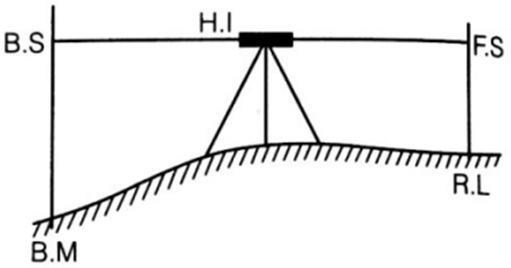Levelling
By BYJU'S Exam Prep
Updated on: September 25th, 2023

Through Champion Study Plan for GATE Civil Engineering (CE) 2022, we are providing Levelling study notes and other important materials on every topic of each subject.
These topic-wise study notes are useful for the preparation of various upcoming exams like GATE Civil/ IES/ BARC/ ISRO/ SSC-JE/ State Engineering Services examinations and other important upcoming competitive exams.
This article contains basic notes on the “Levelling” topic of the “Surveying” subject.
Table of content
Levelling
Definitions
(i) Reduced level: The elevation of a point with respect to either Mean Sea Level (MSL) or with respect to a fixed point of known height is called reduced level.
(ii) Benchmark: Benchmark is a relatively permanent point of reference whose elevation with respect to some assumed datum is known. It is used either as a starting point for leveling or as a point upon which to close as a check.

(iii) Back sight: After setting up the instrument Ist reading taken is called back sight. It is also known as plus sight.
(iv) Fore sight: Last reading taken from an instrument station is called fore sight. It is also known as minus sight.
(v) Intermediate sight: All readings other than back sight and fore sight are intermediate sight.
(vi) Height of instrument: It is the Reduced Level (RL) of line of sight of the instrument set up at different stations.
H.I = R.L + B.S
R.L = H.I – F.S
Arithmetic Check
(i) For rise and fall method
∑B.S – ∑F.S = ∑Rise – ∑Fall = Last R.L – First R.L
(ii) Height of instrument method
∑ B.S – ∑ F.S = Last R.L – First R.L
Reciprocal Levelling

Here, X = error due to inclined line of sight, and
e = error due to curvature and refraction

When instrument is set up at A
Reading on staff at A = hA
Reading on staff at B = hB
When an instrument is set up at B
Reading on staff at A = h’A
Reading on staff at B = h’B
hA – hB = h’A – h’B If instrument is correct.
![]()
Here ‘H’ is the true difference of R.L between A and B.
True Readings

Curvature Correction (CC)

Here, d = horizontal distance between A and B
R = radius of earth
If R = 6370 km
Than CC = -0.07849d2
here ‘CC’ is in meter and ‘d’ is in kilometre

Refraction Correction (CR)

Here d is in kilometer.
Combined Correction Due to Curvature and Refraction (C)

C = -0.06728d2 meter Here d is in kilometer.
Distance of Visible Horizon
d = 3.8553√ckm
Here ‘C’ being in meters. (taking both curvature and refraction into accounts)

Sensitiveness of Bubble Tube
Sensitiveness of the bubble tube is defined as the angular value of one division of the bubble tube.
α’ = sensitivity of the bubble tube
= angular value of one division


Here, S = difference between two staff readings.
n = no. of divisions of bubble

where, l = length of one division
R = radius of curvature of bubble tube.
Contouring
Contours: Contour is an imaginary line joining points of equal elevation on earth surface.
Contour interval: Vertical distance between two contour is called contour internal.
Some suitable value of contour intervals

Contour internal for various purposes are suggested as:


*****
If you are preparing for ESE/ GATE or other PSU Exams (Civil Engineering), then avail Online Classroom Program for ESE and GATE CE:
Online Classroom Program for ESE/GATE CE
You can avail of BYJU’S Exam Prep Test Series specially designed for all Civil Engineering Exams:
BYJU’S Exam Prep Test Series ESE/GATE CE
Thanks
All the Best


